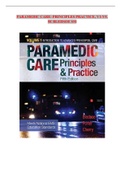Exam (elaborations)
PARAMEDIC CARE- PRINCIPLES PRACTICE, V1-V5, 5E BLEDSOE SM TestBank
Course
PARAMEDIC CARE- PRINCIPLES PRACTICE, V1-V5, 5E BLE
Institution
PARAMEDIC CARE- PRINCIPLES PRACTICE, V1-V5, 5E BLE
PARAMEDIC CARE- PRINCIPLES PRACTICE, V1-V5, 5E BLEDSOE SM TestBank
PARAMEDIC CARE- PRINCIPLES PRACTICE, V1-V5,
5E BLEDSOE SM1
Copyright © 2017 Pearson Education, Inc.
Paramedic Care: Principles & Practice V. 1-5, 5e (Bledsoe)
Volume 1 Introduction to Advanced Prehospital Care
Chapter 1 Int...
[Show more]
Preview 4 out of 793 pages
Uploaded on
October 17, 2022
Number of pages
793
Written in
2022/2023
Type
Exam (elaborations)
Contains
Questions & answers
v1 v5 v1 v5 paramedic care principles practice
5e bledsoe sm testbank paramedic care principles practice
5e bledsoe sm1 copyright © 2017 pearson education
inc paramedic care principles amp
Institution
PARAMEDIC CARE- PRINCIPLES PRACTICE, V1-V5, 5E BLE
Course
PARAMEDIC CARE- PRINCIPLES PRACTICE, V1-V5, 5E BLE
$26.00
100% satisfaction guarantee
Immediately available after payment
Both online and in PDF
No strings attached
PARAMEDIC CARE - PRINCIPLES PRACTICE, V1 -V5, 5E BLEDSOE SM 1 Copyright © 2017 Pearson Education, Inc. Paramedic Care: Principles & Practice V. 1 -5, 5e (Bledsoe) Volume 1 Introduction to Advanced Prehospital Care Chapter 1 Introduction to Paramedicine 1) What is one of the emerging roles and responsibilities of a paramedic in the 21st century? A) Thir d-party biller B) Managed health care C) Health promotion D) Internet education Answer: C Diff: 1 Page Ref: 4 Standard: Preparatory (EMS Systems) Objective: 4 2) Safety inspections, accident prevention, and medical screening of employees are some of the responsibilities for paramedics working in: A) industrial medicine. B) community clinics. C) correctional institutions. D) sports medicine. Answer: A Diff: 1 Page Ref: 8 Standard: Preparatory (EMS Systems) Objective: 5 3) Which of the following best describes the initial education program of the paramedic? A) It addresses everything one needs to know to practice paramedicine. B) It is a rite of passage, but information is inconsistent with how things really should be done. C) It is the base and beginning of one's professional education, not the end. D) Lectures prepare students, but all learning occurs on the job during the internship phase. Answer: C Diff: 1 Page Ref: 5 Standard: Preparatory (EMS Systems) Objective: 3 4) Which of the foll owing best describes the paramedic's professional obligation? A) Acceptance and adherence to a code of professional ethics and etiquette B) Placing the system's well -being above that of the patient C) Absolute adherence to medical protocols D) Following lo ng-standing traditions in practice Answer: A Diff: 2 Page Ref: 6 Standard: Preparatory (EMS Systems) Objective: 3 2 Copyright © 2017 Pearson Education, Inc. 5) A major advance in the education of out -of-hospital was the: A) formation of the National Association of Emergency Medical Technicia ns. B) 2009 publication National EMS Services Education Standards . C) passage of the Health Insurance Portability and Accountability Act (HIPAA). D) establishment of the National Registry computer -based certification exam. Answer: B Diff: 1 Page Ref: 5 Standard: Preparatory (EMS Systems) Objective: 4 6) Which of the following statements about a paramedic's skill competency is TRUE? A) High -frequency, low -criticality skills should be reviewed often. B) Low -frequency, high -criticality skills should be rarely reviewed. C) All skills should be reviewed equally, regardless of criticality. D) Frequent review of infrequently used skills is critical to ensure competency. Answer: D Diff: 1 Page Ref: 5 Standard: Preparatory (EMS Systems) Objective: 3 7) The paramedic's right to care for patients, administer medications, and perform other related tasks falls on the license of: A) the EMS system medical director. B) the state secretary of health. C) the receiving hospital personnel. D) the state medical dir ector. Answer: A Diff: 1 Page Ref: 4 Standard: Preparatory (EMS Systems) Objective: 4 8) Many professional sports teams have found paramedics to be effective complements to their: A) team physicians. B) physical therapists. C) athletic trainers. D) rehabilitation programs. Answer: C Diff: 1 Page Ref: 8 Standard: Preparatory (EMS Systems) Objective: 5 3 Copyright © 2017 Pearson Education, Inc. 9) Paramedics should always provide care: A) with the intent of transporting all patients. B) only when there is a legitimate patient complaint. C) without regard to a patient's ability to pay. D) with the goal of minimizing on -scene time. Answer: C Diff: 1 Page Ref: 4 Standard: Preparatory (EMS Systems) Objective: 4 10) The paramedic's role has expanded to include ________ because of the ne ed to move ill/injured patients from one health care facility to another for specialized care. A) hospital emergency departments B) critical care transport C) corrections medicine D) helicopter EMS Answer: B Diff: 1 Page Ref: 6 Standard: Preparatory ( EMS Systems) Objective: 4 11) Which of the following best characterizes the professional development of a paramedic? A) It is a career -long pursuit. B) It is focused on public education efforts. C) It is regulated by the system medical director and state agency. D) It is focused on illness and injury prevention. Answer: A Diff: 1 Page Ref: 5 Standard: Preparatory (EMS Systems) Objective: 3 12) Which of the following best describes the paramedic's expected level of functioning in the dynamic prehosp ital setting? A) Acts independently B) Under direct supervision of the medical director C) Under telephone or radio supervision by nursing personnel D) Under direct supervision of fire command Answer: A Diff: 1 Page Ref: 5 Standard: Preparatory (EMS S ystems) Objective: 3




